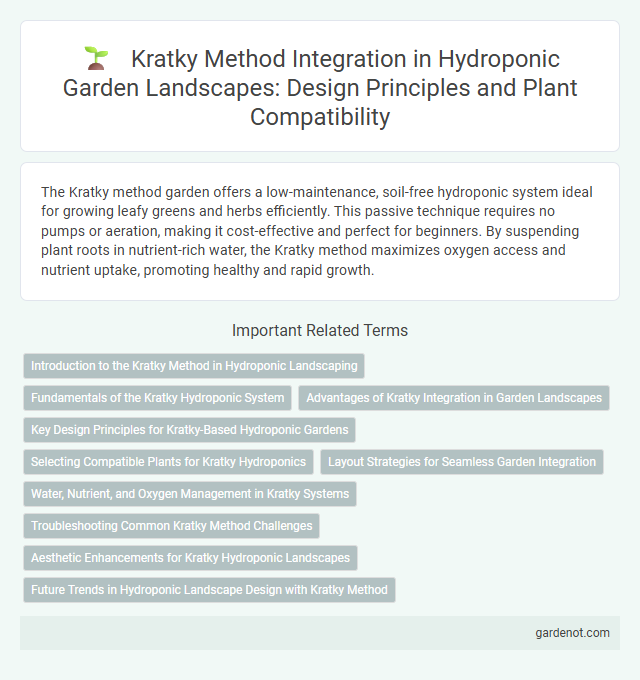The Kratky method garden offers a low-maintenance, soil-free hydroponic system ideal for growing leafy greens and herbs efficiently. This passive technique requires no pumps or aeration, making it cost-effective and perfect for beginners. By suspending plant roots in nutrient-rich water, the Kratky method maximizes oxygen access and nutrient uptake, promoting healthy and rapid growth.
Introduction to the Kratky Method in Hydroponic Landscaping
The Kratky method is a passive hydroponic technique ideal for sustainable landscaping, requiring no pumps or electricity by suspending plants in nutrient-rich water. This soil-less approach promotes efficient water use and reduces maintenance, making it suitable for urban gardens and green spaces. Its simplicity and scalability allow landscapers to design visually appealing, eco-friendly installations with minimal resource inputs.
Fundamentals of the Kratky Hydroponic System
The Kratky hydroponic system operates on a passive, non-circulating method where plants grow suspended in a nutrient solution, allowing roots to access oxygen as water levels drop. This technique eliminates the need for pumps or electricity, relying solely on the air gap formed between the nutrient solution and the plant roots for oxygenation. Its fundamental components include a reservoir for nutrient solution, a lid to suspend plants, and proper nutrient concentration to support optimal growth without active aeration.
Advantages of Kratky Integration in Garden Landscapes
Kratky method integration in garden landscapes offers a soil-free, low-maintenance hydroponic solution that conserves water by up to 90% compared to traditional gardening. This passive system requires no pumps or electricity, making it cost-effective and ideal for sustainable urban and indoor gardens. Enhanced plant growth and higher yields result from consistent nutrient availability and oxygenation in the Kratky method, optimizing space and resource efficiency in diverse landscape designs.
Key Design Principles for Kratky-Based Hydroponic Gardens
Kratky method gardens rely on a simple, passive hydroponic system where plants grow in nutrient-rich water without continuous aeration. Key design principles include maintaining an air gap between the nutrient solution and plant roots to ensure oxygen availability and monitoring solution levels to prevent root submersion. Using opaque containers helps reduce algae growth, while selecting appropriate plant spacing optimizes nutrient uptake and light exposure.
Selecting Compatible Plants for Kratky Hydroponics
Selecting compatible plants for Kratky hydroponics involves choosing species with similar water and nutrient requirements to ensure balanced growth. Leafy greens like lettuce, spinach, and herbs such as basil and mint thrive in this passive system due to their low nutrient demand and rapid growth. Avoiding large fruiting plants like tomatoes or peppers prevents oxygen depletion and nutrient imbalances, optimizing overall system performance.
Layout Strategies for Seamless Garden Integration
Krathky method garden layout strategies emphasize maximizing space efficiency and optimizing nutrient delivery by arranging plants in modular, scalable units with well-planned spacing to ensure root aeration and light exposure. Utilizing vertical stacking and tiered platforms enhances seamless integration into existing landscapes, promoting biodiversity and aesthetic appeal without extensive soil preparation or irrigation systems. Strategic placement near natural light sources and incorporation of water reservoirs within design reduces maintenance needs while supporting robust plant growth in hydroponic systems.
Water, Nutrient, and Oxygen Management in Kratky Systems
The Kratky method garden optimizes water usage by maintaining a static reservoir that gradually depletes as plants absorb nutrients and moisture, reducing the need for continuous watering. Nutrient management relies on a carefully balanced solution within the reservoir, providing essential macro- and micronutrients to support rapid plant growth. Oxygen availability is naturally maintained by an air gap between the water surface and plant roots, preventing root rot and promoting healthy aerobic respiration without the need for aeration devices.
Troubleshooting Common Kratky Method Challenges
Troubleshooting common Kratky method challenges involves addressing nutrient deficiencies by regularly monitoring pH levels and ensuring proper aeration in the nutrient solution to prevent root rot. Managing water evaporation and topping off nutrient reservoirs helps maintain optimal plant growth conditions and prevents nutrient imbalances. Regular inspection for pests and diseases further supports healthy hydroponic garden development using the Kratky method.
Aesthetic Enhancements for Kratky Hydroponic Landscapes
Kratky method gardens elevate hydroponic landscapes by integrating vibrant leafy greens and flowering herbs that create visually appealing, low-maintenance displays. The suspended nutrient solution tanks can be artistically designed with modern geometric shapes or natural textures to complement outdoor settings and enhance curb appeal. Utilizing LED grow lights with customizable colors further accentuates plant colors and shapes, transforming Kratky setups into dynamic, aesthetically pleasing focal points in urban or indoor spaces.
Future Trends in Hydroponic Landscape Design with Kratky Method
Future trends in hydroponic landscape design with the Kratky method emphasize sustainability through soil-less cultivation and reduced water usage, making it ideal for urban environments. Integration of automated nutrient monitoring systems and eco-friendly materials enhances resource efficiency and plant health. Advances in vertical Kratky gardens are expected to optimize space utilization, promoting green infrastructure in densely populated areas.
Kratky method garden Infographic

 gardenot.com
gardenot.com